英语诗歌修辞手法简介Figures_of_speech PPT
- 格式:ppt
- 大小:905.50 KB
- 文档页数:68
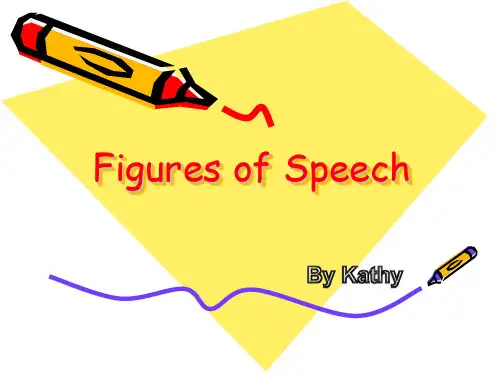
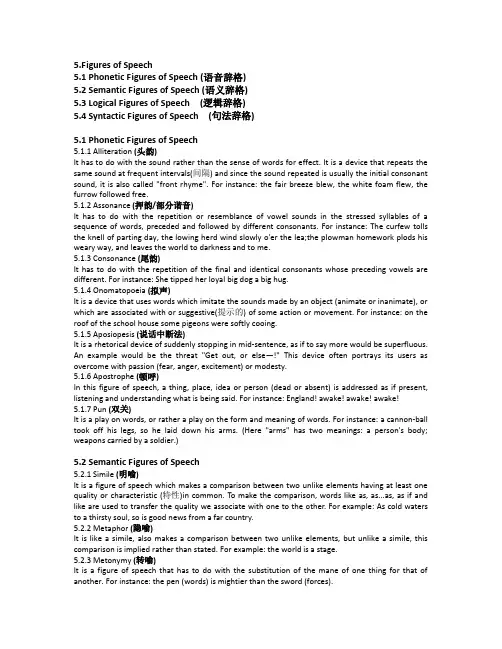
5.Figures of Speech5.1 Phonetic Figures of Speech (语音辞格)5.2 Semantic Figures of Speech (语义辞格)5.3 Logical Figures of Speech (逻辑辞格)5.4 Syntactic Figures of Speech (句法辞格)5.1 Phonetic Figures of Speech5.1.1 Alliteration (头韵)It has to do with the sound rather than the sense of words for effect. It is a device that repeats the same sound at frequent intervals(间隔) and since the sound repeated is usually the initial consonant sound, it is also called "front rhyme". For instance: the fair breeze blew, the white foam flew, the furrow followed free.5.1.2 Assonance (押韵/部分谐音)It has to do with the repetition or resemblance of vowel sounds in the stressed syllables of a sequence of words, preceded and followed by different consonants. For instance: The curfew tolls the knell of parting day, the lowing herd wind slowly o'er the lea;the plowman homework plods his weary way, and leaves the world to darkness and to me.5.1.3 Consonance (尾韵)It has to do with the repetition of the final and identical consonants whose preceding vowels are different. For instance: She tipped her loyal big dog a big hug.5.1.4 Onomatopoeia (拟声)It is a device that uses words which imitate the sounds made by an object (animate or inanimate), or which are associated with or suggestive(提示的) of some action or movement. For instance: on the roof of the school house some pigeons were softly cooing.5.1.5 Aposiopesis (说话中断法)It is a rhetorical device of suddenly stopping in mid-sentence, as if to say more would be superfluous. An example would be the threat "Get out, or else—!" This device often portrays its users as overcome with passion (fear, anger, excitement) or modesty.5.1.6 Apostrophe (顿呼)In this figure of speech, a thing, place, idea or person (dead or absent) is addressed as if present, listening and understanding what is being said. For instance: England! awake! awake! awake!5.1.7 Pun (双关)It is a play on words, or rather a play on the form and meaning of words. For instance: a cannon-ball took off his legs, so he laid down his arms. (Here "arms" has two meanings: a person's body; weapons carried by a soldier.)5.2 Semantic Figures of Speech5.2.1 Simile (明喻)It is a figure of speech which makes a comparison between two unlike elements having at least one quality or characteristic (特性)in common. To make the comparison, words like as, as...as, as if and like are used to transfer the quality we associate with one to the other. For example: As cold waters to a thirsty soul, so is good news from a far country.5.2.2 Metaphor (隐喻)It is like a simile, also makes a comparison between two unlike elements, but unlike a simile, this comparison is implied rather than stated. For example: the world is a stage.5.2.3 Metonymy (转喻)It is a figure of speech that has to do with the substitution of the mane of one thing for that of another. For instance: the pen (words) is mightier than the sword (forces).5.2.4 Synecdoche (提喻)It is involves the substitution of the part for the whole, or the whole for the part. For instance: they say there's bread and work for all. She was dressed in silks.5.2.5 Antonomasia (换喻)It has also to do with substitution. It is not often mentioned now, though it is still in frequent use. For example: Solomon for a wise man; Daniel for a wise and fair judge; Judas for a traitor.5.2.6 Personification (拟人)It gives human form of feelings to animals, or life and personal attributes(赋予) to inanimate(无生命的) objects, or to ideas and abstractions(抽象). For example: the wind whistled through the trees. 5.2.7 Parody (戏仿)It is a kind of imitation which borrows the style and techniques of a text or writer’s idiolect and fits new subject matter to it. It is often used for a humorous or satirical purpose. For example: to smoke or not to smoke, that is a question.5.2.8 Synesthesia (通感)It refers to the mixing of sensations or the stimulation of one sense that produces a mental impression associated with a different sense. For example: Posner lipstick:Music to your lips.5.2.9 Transferred epithet (移就)It is a figure of speech where an epithet (an adjective or descriptive phrase) is transferred from the noun it should rightly modify(修饰) to another to which it does not really apply or belong. For instance: I spent sleepless nights on my project.5.3 Logical Figures of Speech*5.3.1 Allegory (讽喻)Allegory is a story either in verse or in prose with a double meaning: surface meaning—a story, and under-the-surface meaning—a hidden truth. In allegories, names of the characters and places are often symbols of certain qualities. In Banyan’s Pilgrim’s Progress, from the names of the characters “Christian”, “Mr. Blind-man”, ‘Mr. No-good”, the names of places “Vanity Fair”, “Celestial City”, we can easily understand the meaning behind these names.*5.3.2 Allusion (暗引)It is a casual, brief and implicit reference to a famous historical or literary figure or a well-known historical event. For instance: she sat there all night as silent as the sphinx.5.3.3 Hyperbole (夸张)It is the deliberate use of overstatement or exaggeration to achieve emphasis. For instance: he almost died laughing.5.3.4 Understatement (含蓄陈述)It is the opposite of hyperbole, or overstatement. It achieves its effect of emphasizing a fact by deliberately(故意地) understating it, impressing the listener or the reader more by what is merely implied or left unsaid than by bare statement. For instance: It is no laughing matter.5.3.5 Irony (反语)It is a figure of speech that achieves emphasis by saying the opposite of what is meant, the intended meaning of the words being the opposite of their usual sense. For instance: we are lucky, what you said makes me feel real good.5.3.6 Innuendo (暗讽)It is a mild form of irony, hinting in a rather roundabout (曲折)way at something disparaging(不一致) or uncomplimentary(不赞美) to the person or subject mentioned. For example: the weatherman said it would be worm. He must take his readings in a bathroom.5.3.7 Euphemism (委婉)It is the substitution of an agreeable or inoffensive(无冒犯) expression for one that may offend or suggest something unpleasant. For instance: we refer to "die" as " pass away".5.3.8 Oxymoron (矛盾修饰)It is a compressed paradox, formed by the conjoining(结合) of two contrasting, contradictory or incongruous(不协调) terms as in “bitter-sweet memories”, “orderly chaos” and “proud humility”.*5.3.9 Analogy (类比)It is also a form of comparison, but unlike simile or metaphor which usually uses comparison on one point of resemblance, analogy draws a parallel between two unlike things that have several common qualities or points of resemblance.5.3.10 Paradox (隽语)It is a figure of speech consisting of a statement or proposition which on the face of it seems self-contradictory, absurd or contrary to established fact or practice, but which on further thinking and study may prove to be true, well-founded, and even to contain a succinct point. For example: more haste, less speed.5.4 Syntactic Figures of Speech5.4.1 Repetition (反复)It is a powerful rhetorical device which creates good rhythm and parallelism to make the language musical, emphatic, attractive and memorable. For example: one boy is a boy, two boys half a boy, three boys no boy.5.4.2 Anaphora (首语重复)It is the repetition of the same word at the beginning of successive clauses, sentences or verses, commonly in conjunction with climax and with parallelism. For example: out of sight, out of mind. 5.4.3 Epiphora (尾词重复)It is the repetition of the same words or phrases at the end of successive clauses. For example: grasp all, lose all.5.4.4 Simploce (首尾同复)It is a combination of anaphora and epiphora: the repetition of two sets of words or phrases, one set repeated at the beginning of, the other set repeated at the end of sentences or verse lines. The pattern is “a…b, a…b”.For example: broadly speaking, human beings may be divided into three classes: those who are toiled to death, those who are worried to death, and those who are bored to death.5.4.5 Anadiplosis (蝉联)It is the repetition of the last part of one unit or sentence at the beginning of the next, whose pattern is /…a, a…(b, b…c, c..)/. For example: The king was bad tempered because he was often ill. He was often ill because he ate and drank too much.5.4.6 Parallelism (平行结构)It refers to the method of expressing ideas of equal importance in the same grammatical form, and elements parallel in meaning should be parallel in syntactic structure. For example: Rich and poor, intelligent and ignorant, wise and foolish, virtuous and vicious, man and woman-it is ever the same, each soul must depend wholly on itself.5.4.7 Antithesis (对偶)It is the deliberate arrangement of contrasting words or ideas in balanced structural forms to achieve emphasis. For example: speech is silvern; silence is golden.5.4.8 Climax (层进法)It is derived from the Greek word for "ladder" and implies the progression of thought at a uniform or almost uniform rate of significance or intensity, like the steps of a ladder ascending evenly. For example: I came, I saw, I conquered.5.4.9 Anticlimax (突降法)It is the opposite of Climax. It involves stating one's thoughts in a descending order of significance or intensity, from strong to weak, from weighty to light or frivolous. For instance: He lost his empire, hisfamily and his fountain pen.5.4.10 Syllepsis(一笔两用法)It has two connotations. In the first case, it is a figure by which a word, or a particular form or inflection of a word, refers to two or more words in the same sentence, while properly applyingto or agreeing with only on of them in grammar or syntax(句法). For example: He addressed you and me, and desired us to follow him. (Here us is used to refer to you and me.) In the second case, it a word may refer to two or more words in the same sentence. For example: while he was fighting , and losing limb and mind, and dying, others stayed behind to pursue education and career. (Here to losing one's limbs in literal; to lose one's mind is figurative, and means to go mad.)5.4.11 Chiasmus (交错法)It is a construction involving the repetition of words or elements in reverse order (a b : b a).Beauty is truth, truth (is) beauty. For example: You can fool all the people some of the time, and some of the people all the time, but you cannot fool all the people all the time.5.4.12 Asyndeton (连词省略)It refers to the deliberate omission of the co-ordinator in a series of words, phrases or clauses. For example: They spent the day wondering, searching, thinking, (and )understanding.5.4.13 Polysyndeton (连词叠用)It is a stylistic device that uses several conjunctions (usually the same one) in succession to link up a series of things, ideas or events. The conjunctions involved are mainly and and or. For example: advancing and prancing and glancing and dancing.5.4.14 Rhetorical question(反问句)It is a question which does not need an answer, for the answer is suggested by the speaker, or presumed by the speaker to be fairly obvious or probably known to the audience--the equivalent of a statement. For example: If Winter comes, can Spring be far behind?。
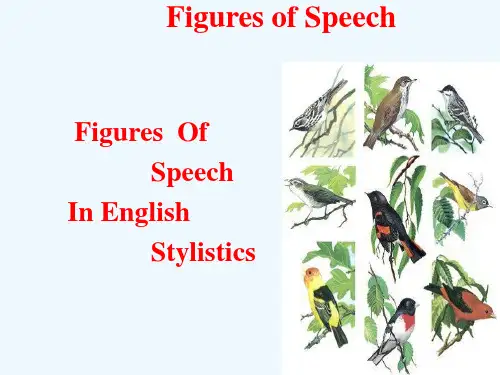
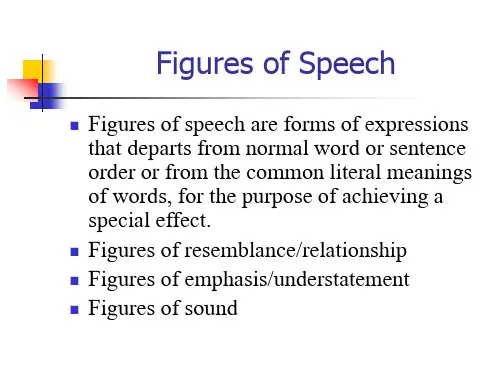
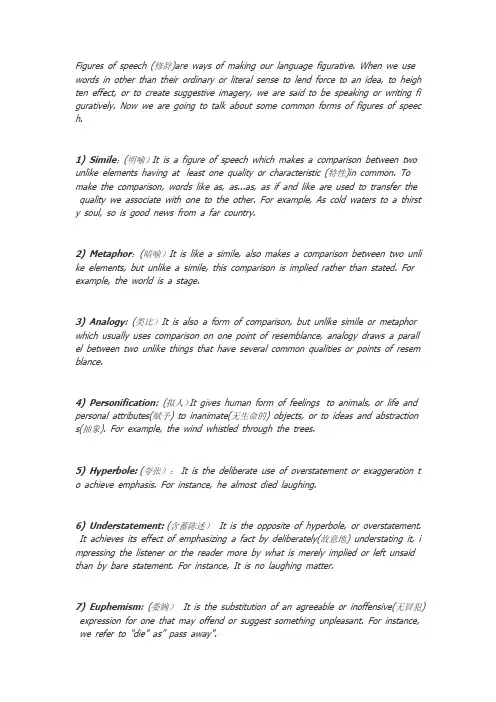
Figures of speech (修辞)are ways of making our language figurative. When we use words in other than their ordinary or literal sense to lend force to an idea, to heigh ten effect, or to create suggestive imagery, we are said to be speaking or writing fi guratively. Now we are going to talk about some common forms of figures of speec h.1) Simile:(明喻)It is a figure of speech which makes a comparison between two unlike elements having at least one quality or characteristic (特性)in common. To make the comparison, words like as, as...as, as if and like are used to transfer the quality we associate with one to the other. For example, As cold waters to a thirst y soul, so is good news from a far country.2) Metaphor:(暗喻)It is like a simile, also makes a comparison between two unli ke elements, but unlike a simile, this comparison is implied rather than stated. For example, the world is a stage.3) Analogy: (类比)It is also a form of comparison, but unlike simile or metaphor which usually uses comparison on one point of resemblance, analogy draws a parall el between two unlike things that have several common qualities or points of resem blance.4) Personification: (拟人)It gives human form of feelings to animals, or life and personal attributes(赋予) to inanimate(无生命的) objects, or to ideas and abstraction s(抽象). For example, the wind whistled through the trees.5) Hyperbole: (夸张): It is the deliberate use of overstatement or exaggeration t o achieve emphasis. For instance, he almost died laughing.6) Understatement: (含蓄陈述)It is the opposite of hyperbole, or overstatement. It achieves its effect of emphasizing a fact by deliberately(故意地) understating it, i mpressing the listener or the reader more by what is merely implied or left unsaid than by bare statement. For instance, It is no laughing matter.7) Euphemism: (委婉)It is the substitution of an agreeable or inoffensive(无冒犯) expression for one that may offend or suggest something unpleasant. For instance, we refer to "die" as” pass away".8) Metonymy (转喻)It is a figure of speech that has to do with the substitution of the mane of one thing for that of another. For instance, the pen (words) is mi ghtier than the sword (forces).9) Synecdoche (提喻)It is involves the substitution of the part for the whole, or the whole for the part. For instance, they say there's bread and work for all. She was dressed in silks.10) Antonomasia (换喻)It has also to do with substitution. It is not often mentio ned now, though it is still in frequent use. For example, Solomon for a wise man. Daniel for a wise and fair judge. Judas for a traitor.11) Pun: (双关语)It is a play on words, or rather a play on the form and meani ng of words. For instance, a cannon-ball took off his legs, so he laid down his arm s. (Here "arms" has two meanings: a person's body; weapons carried by a soldier.)12) Solipsism: (一语双叙)It has two connotations. In the first case, it is a figure by which a word, or a particular form or inflection of a word, refers to two or m ore words in the same sentence, while properly applying to or agreeing with only o n of them in grammar or syntax(句法). For example, He addressed you and me, an d desired us to follow him. (Here we are used to refer to you and me.)In the second case, it a word may refer to two or more words in the same sente nce. For example, while he was fighting, and losing limb and mind, and dying, othe rs stayed behind to pursue education and career. (Here to losing one's limbs in liter al; to lose one's mind is figurative, and means to go mad.)13) Zeugma: (轭式搭配)It is a single word which is made to modify or to gover n two or more words in the same sentence, wither properly applying in sense to o nly one of them, or applying to them in different senses. For example, the sun shal l not burn you by day or the moon by night. (Here noon is not strong enough to burn)14) Irony: (反语)It is a figure of speech that achieves emphasis by saying the opposite of what is meant, the intended meaning of the words being the opposite of their usual sense. For instance, we are lucky, what you said makes me feel realgood.15) Innuendo: (暗讽)It is a mild form of irony, hinting in a rather roundab out (曲折)way at something disparaging(不一致) or uncomplimentary(不赞美) to the person or subject mentioned. For example, the weatherman said it would be worm. He must take his readings in a bathroom.16) Sarcasm: (讽刺)It Sarcasm is a strong form of irony. It attacks in a taunting and bitter manner, and its aim is to disparage, ridicule and wound the feelings of the subject attacked. For example, laws are like cobwebs, which may catch small f lies, but let wasps break through.17) Paradox: (似非而是的隽语)It is a figure of speech consisting of a statement or proposition which on the face of it seems self-contradictory, absurd or contrary t oestablished fact or practice, but which onfurther thinking and study may prove to be true, well-founded, and even to contain a succinct point. For example more hast e, less speed.18) Oxymoron: (矛盾修饰)It is a compressed paradox, formed by the conjoinin g(结合) of two contrasting, contradictory or incongruous(不协调) terms as in bitter-s weet memories, orderly chaos(混乱) and proud humility(侮辱).19) Antithesis: (对照)It is the deliberate arrangement of contrasting words or i deas in balanced structural forms to achieve emphasis. For example, speech is silver; silence is golden.20) Epigram: (警句)It states a simple truth pithily(有利地) and pungently(强烈地). It is usually terse and arouses interest and surprise by its deep insight into certain aspects of human behavior or feeling. For instance, Few, save the poor, feel for the poor.21) Climax: (渐进)It is derived from the Greek word for "ladder" and implies the progression of thought at a uniform or almost uniform rate of significance or inte nsity, like the steps of a ladder ascending evenly. For example, I came, I saw, I co nquered.22) Anti-climax or bathos: (突降) It is the opposite of Climax. It involves stating one's thoughts in a descending order of significance or intensity, from strong to weak, from weighty to light or frivolous. For instance, But thousands die, without or this or that, die, and endow(赋予) a college, or a cat.23) Apostrophe:(顿呼)In this figure of speech, a thing, place, idea or perso n (dead or absent) is addressed as if present, listening and understanding what is being said.For instance, England! awake! awake! awake!24) Transferred Epithet: (转类形容词)It is a figure of speech where an epithet (an adjective or descriptive phrase) is transferred from the noun it should rightly m odify(修饰) to another to which it does not really apply or belong. For instance, I s pent sleepless nights on my project.25) Alliteration: (头韵)It has to do with the sound rather than the sense of wo rds for effect. It is a device that repeats the same sound at frequent intervals(间隔) and since the sound repeated is usually the initial consonant sound, it is also calle d "front rhyme". For instance, the fair breeze blew, the white foam flew, the furrow followed free.26) Onomatopoeia: (拟声)It is a device that uses words which imitate the soun ds made by an object (animate or inanimate), or which are associated with or sug gestive(提示的) of some action or movement。
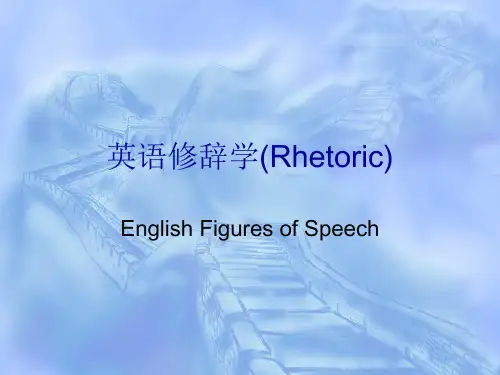
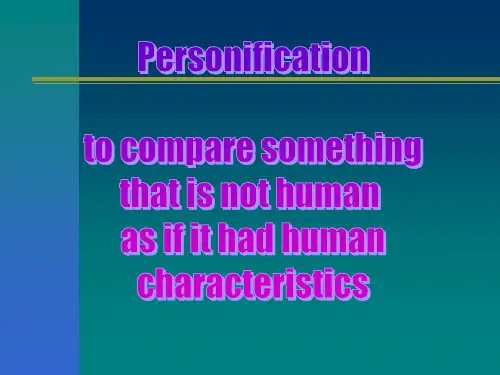
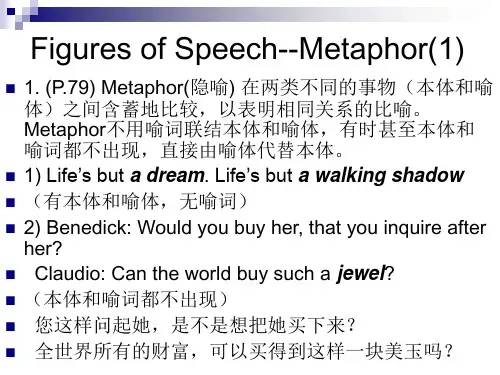
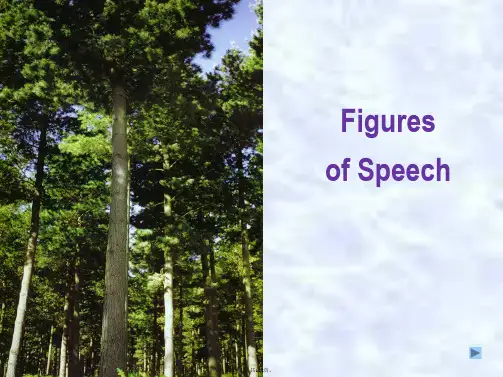
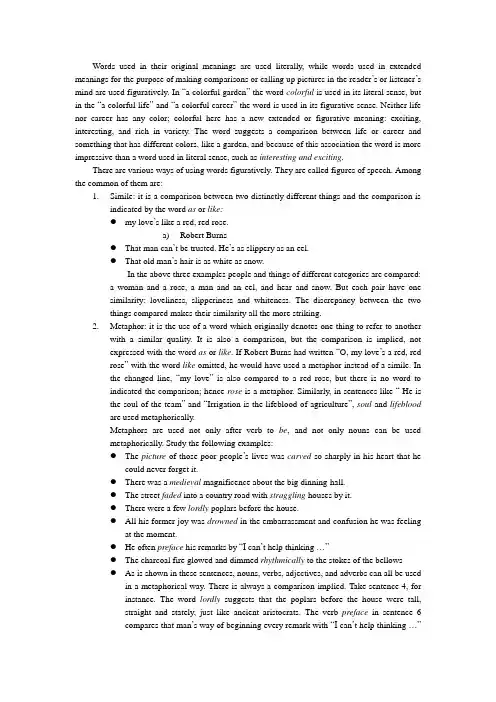
Words used in their original meanings are used literally, while words used in extended meanings for the purpose of making comparisons or calling up pictures in the reader’s or listener’s mind are used figuratively. In “a colorful garden” the word colorful is used in its literal sense, but in the “a colorful life” and “a colorful career” the word is used in its figurative sense. Neither life nor career has any color; colorful here has a new extended or figurative meaning: exciting, interesting, and rich in variety. The word suggests a comparison between life or career and something that has different colors, like a garden, and because of this association the word is more impressive than a word used in literal sense, such as interesting and exciting.There are various ways of using words figuratively. They are called figures of speech. Among the common of them are:1.Simile: it is a comparison between two distinctly different things and the comparison isindicated by the word as or like:●my love’s like a red, red rose.a)Robert Burns●That man can’t be trusted. He’s as slippery as an eel.●That old man’s hair is as white as snow.In the above three examples people and things of different categories are compared:a woman and a rose, a man and an eel, and hear and snow. But each pair have onesimilarity: loveliness, slipperiness and whiteness. The discrepancy between the twothings compared makes their similarity all the more striking.2.Metaphor: it is the use of a word which originally denotes one thing to refer to anotherwith a similar quality. It is also a comparison, but the comparison is implied, notexpressed with the word as or like. If Robert Burns had written “O, my love’s a red, redrose” with the word like omitted, he would have used a metaphor instead of a simile. Inthe changed line, “my love”is also compared to a red rose, but there is no word toindicated the comparison; hence rose is a metaphor. Similarly, in sentences like “ He isthe soul of the team” and “Irrigation is the lifeblood of agriculture”, soul and lifebloodare used metaphorically.Metaphors are used not only after verb to be, and not only nouns can be usedmetaphorically. Study the following examples:●The picture of those poor people’s lives was carved so sharply in his heart that hecould never forget it.●There was a medieval magnificence about the big dinning-hall.●The street faded into a country road with straggling houses by it.●There were a few lordly poplars before the house.●All his former joy was drowned in the embarrassment and confusion he was feelingat the moment.●He often preface his remarks by “I can’t help thinking …”●The charcoal fire glowed and dimmed rhythmically to the stokes of the bellows●As is shown in these sentences, nouns, verbs, adjectives, and adverbs can all be usedin a metaphorical way. There is always a comparison implied. Take sentence 4, forinstance. The word lordly suggests that the poplars before the house were tall,straight and stately, just like ancient aristocrats. The verb preface in sentence 6compares that man’s way of beginning every remark with “I can’t help thinking …”to providing a preface to a book.A metaphor or a simile has to be fresh to be effective. One that has been frequentlyused over a long period of time will become dull and stale, and cease to function asa metaphor or simile. “the leg of a table” must have been a metaphor when it wasfirst used, but today we feel that leg is used in its literal sense.3.Personification: it is to treat a thing or an idea as if it were human or had humanqualities. In poetry personification is very common:●Y outh is hot and bold,Age is weak and cold,Y outh is wild, and Age is tame.William ShakespeareIn these lines Y outh and Age are described like two persons. In prose personificationis also used, though not so often as in poetry.●The match will soon be over and defeat is staring us in the face.●This time fate was smiling to him.●Thunder roared and a pouring rain started.●Dusk came stealthily.●The storm was raging and angry sea was continuously tossing their boat.4.Metonymy: it is substituting the name of one thing for that of another with which it isclosely associated. Thus the crown can stand for a king, and the White House for the American government, the bottle for wine or alcohol, and the bar for the legal profession.When metonymy is well used, brevity and vividness may be achieved:●Sword and cross in hand, the European conquerors fell upon the Americans.●When the war was over, he laid down the sword and took up the pen.●His purse would not allow him that luxury.5.Synecdoche: when a part is substituted for the whole or the whole is substituted for apart, synecdoche is applied:●The farms were short of hands during the harvest time.●He had to earn his daily bread by doing odd jobs.●Germany beat Argentina 2 to 1 in this exciting football match.●The poor creature could no longer endure her sufferings.●In the above sentences hands stands for men, bread for food or living expenses,the names of the two countries for the two teams, and creature for a woman.Metonymy and synecdoche are similar as both involve substitution. Sometimesthey can hardly be distinguished from metaphor, which in a way is alsosubstitution.6.Euphemism: it is the substitution of a mild or vague expression for a harsh or unpleasantone, for example:●To die – to pass away, to leave us; one’s heart has stopped beating●Old people – senior citizens●Mad – emotional disturbed●Dustman – sanitation worker●Lavatory – bathroom, men’s (women’s) room●Invasion, raid – military action●Driving inhabitants away and controlling them – pacification●Concentration camp – strategic hamlets●It is obvious that those euphemisms used by the ordinary people are meant to softenharsh reality, but those used by politic ians may aim at deceiving the public.7.Irony: it is the use of words which are clearly opposite to what is meant, in order toachieve a special effect. Suppose you planned an outing on a certain day, expecting it to be fine; but when the day came it was raining heavily. If you said, “What fine weather for an outing!” you were speaking ironically. If a barbarous act was called civilized or cultural, irony was used.8.Overstatement and understatement: in overstatement the diction exaggerates the subject,and in understatement the words play down the magnitude or value of the subject.Overstatement is also called hyperbole.Both aim at the same effect: to make the statement or description impressive or interesting.●She is dying to know what job has been assigned her.●On hearing that he had been admitted to that famous university, he whispered tohimself, “I’m the luckiest man in the world.”●It took a few dollars to build this indoor swimming pool.●“He is really strange,” his friends said when they heard he had divorced his prettyand loving wife.9.Transferred Epithet: an epithet is an adjective or descriptive phrase that serves tocharacterize somebody or something. A transferred epithet is one that is shifted from the noun it logically modifies to a word associated with that noun. When one says that he has had a busy day, one is using such a figure of speech. For it is the person, not the day, that is busy.●She was so worried about her son that she spent several sleepless nights.●In his quiet laziness he suddenly remembered that strange word.●The assistant kept a respectful distance from his boss when they were walking in thecorridor.●He said “Y es” to the question in an unthinking moment.●The old man put a reassuring hand on my shoulder.10.Oxymoron: in oxymoron apparently contradictory terms are combined to produce aspecial effect.●The coach had to be cruel to be kind to his trainees.●When the news of the failure came, all his friends said that it was a victoriousdefeat.●The president was conspicuously absent on that occasion.●She read the long-awaited letter with a tearful smile.11.Alliteration: it refers to the appearance of the same initial consonant sound in two ormore words, such as “p roud as a p eacock” and “b lind as a b at”. Alliteration is often used in poetry to give emphasis to words that are related in meaning:●Wherefore feed, and clothe, and save,From the cradle to the grave,Those ungrateful dr ones who wouldDr ain you sweat – nay, dr ink your blood?Percy Bysshe ShelleyAlliteration is sometimes used in prose for the same effect – to join two or more related words.●I see also the d ull, d rilled, d ocile, brutish masses of the Hun soldiery plodding onlike a swarm of crawling locusts.●The Russian danger is therefore our danger, …just as the cause of any Russianfighting for his h earth and h ome is the cause of free men and free peoples in every quarter of the globe.These two sentences are taken from Winston Churchill’s speech on Hitler’s invasion of the Soviet Union in 1941.。
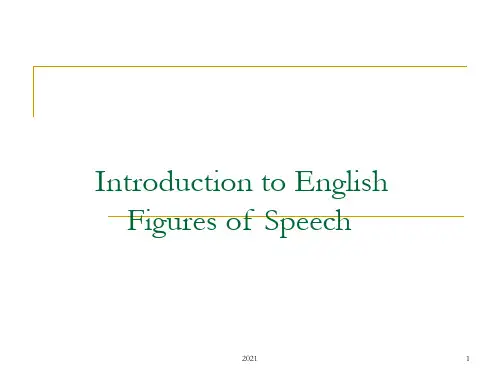
所谓修辞(The figure of speech)是指依据题旨情境恰当地选择语言手段和表达方式, 以有效地表情达意。
修辞的目的是使作品更加形象生动、引人入胜。
了解英语中的修辞, 有助于我们更好地理解、欣赏文章,也有助于在写作中丰富我们自己的表达。
英语修辞格按其构成大致可以分为三类: 词义修辞格.如明喻、反语、委婉语等:结构修辞格.如平行结构、对照、层进、倒装、反复等:音韵修辞格.如头韵法、拟声、元韵等词义修辞格主要是指借助语义的联想和语言的变化等特点创造出来的修辞手法。
大学英语中常见的词义修辞格有以下几种:simile, metaphor, allusion, metonymy, personification, hyperbole, euphemism, irony, oxymoron, synecdoche, pun, zeugma.1.Simile 明喻与汉语的明喻基本相同,是以两种具有相同特征的事物和现象进行对比,表明本体和喻体之间的相似关系。
常用来表示明喻的喻词有like, as, as if, as though等。
如:Learning is like rowing upstream; not to advance is to drop back. 学如逆水行舟,不进则退。
“How like the winter hath my absence been”or “So are you to my thoughts as food to life”(Shakespeare).如“我的离开好象是冬天来临”或“你对我的思想就象食物对于生命一样重要”(莎士比亚)My love's like a red, red rose. 我的爱人像一朵红红的玫瑰花。
The man can't be trusted. He is as slippery as an eel. 那个人不可信赖。